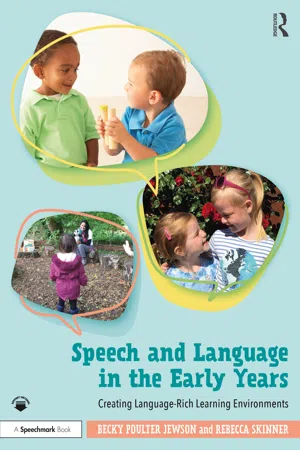
Speech and Language in the Early Years
Creating Language-Rich Learning Environments
Becky Poulter Jewson, Rebecca Skinner
- 184 pages
- English
- ePUB (mobile friendly)
- Available on iOS & Android
Speech and Language in the Early Years
Creating Language-Rich Learning Environments
Becky Poulter Jewson, Rebecca Skinner
About This Book
Speech and Language in the Early Years is an accessible resource, packed full of practical ideas and techniques to support speech and language development in young children.
Learning to communicate is a dynamic process. A child needs a reason to communicate, the motivation to communicate, and, significantly, a responsive communication partner. This book will help you to develop language-rich interactions to facilitate language development in your everyday work and will encourage reflective practice in your setting.
Key features include:
-
- Activities and strategies designed for busy educators to dip in and out of as part of everyday practice, promoting speech and language development as well as supporting those with speech, language, and communication needs
-
- Templates and techniques for reflective practice, supporting the creation of language-rich environments and encouraging mindful communication
-
- Chapters spanning from birth to the transition to school, each exploring different areas of the learning environment
Offering readers the opportunity to extend their skills and confidence in their practice, this book is an essential resource for early years practitioners looking to facilitate quality interactions with the children in their care.
Frequently asked questions
Information
1 Speech and Language Development
What Is Communication?
Reflection PointTake a moment…think about a time when you had some really exciting news to share. Who did you want to tell? What happened? How did they react? How did you feel?Let’s hope this was a positive experience for you. Perhaps the other person shared your excitement, perhaps they showed genuine interest and wanted to know more.It is in these moments that we can reflect back and value that our message – our communication – was listened to and understood. The result was that we felt ‘connected’ to that other person and the experience was positive.What if…What if the other person didn’t share our excitement?What if the other person didn’t listen and started talking about something else?How might that feel?This is a critical point when thinking about communication. A positive experience requires a responsive person who listens and by doing so acknowledges that the person communicating their message is valued.An excited reaction is obviously not always necessary, a smile may be the appropriate response, but let’s be mindful of the communication attempts of the children in our care.We know that some children will be able to have complex conversations, but we also know that for some children eye pointing is their only means of expressing themselves. As early years professionals we must be aware of and value all types of communication.Let us strive to create environments where all children are understood.
How Do We Learn Language?


Emerging Communicator
Stage 1 – Looking, Listening, and Attention
Stage 2 – Making Sounds and Taking Turns
Reflection PointJust think for a moment…what could happen if the child’s vocalisations, movements, and smiles went unnoticed?What might happen if the child doesn’t get positive feedback at this stage?The role of the adult in this stage is so crucial. A child at this stage needs the adults around them to be observant and responsive as they develop these early yet fundamental skills for communication development.
Making Sounds
Table of contents
- Cover
- Half-Title
- Title
- Copyright
- Contents
- Acknowledgements
- Introduction
- Chapter 1 Speech and Language Development
- Chapter 2 Reflective Practice
- Chapter 3 Birth to 18 Months
- Chapter 4 18 Months to Two Years
- Chapter 5 Two to Three Years
- Chapter 6 Pre-Schoolers
- Chapter 7 Transitions into School
- Chapter 8 Speech, Language, and Communication Needs
- Index